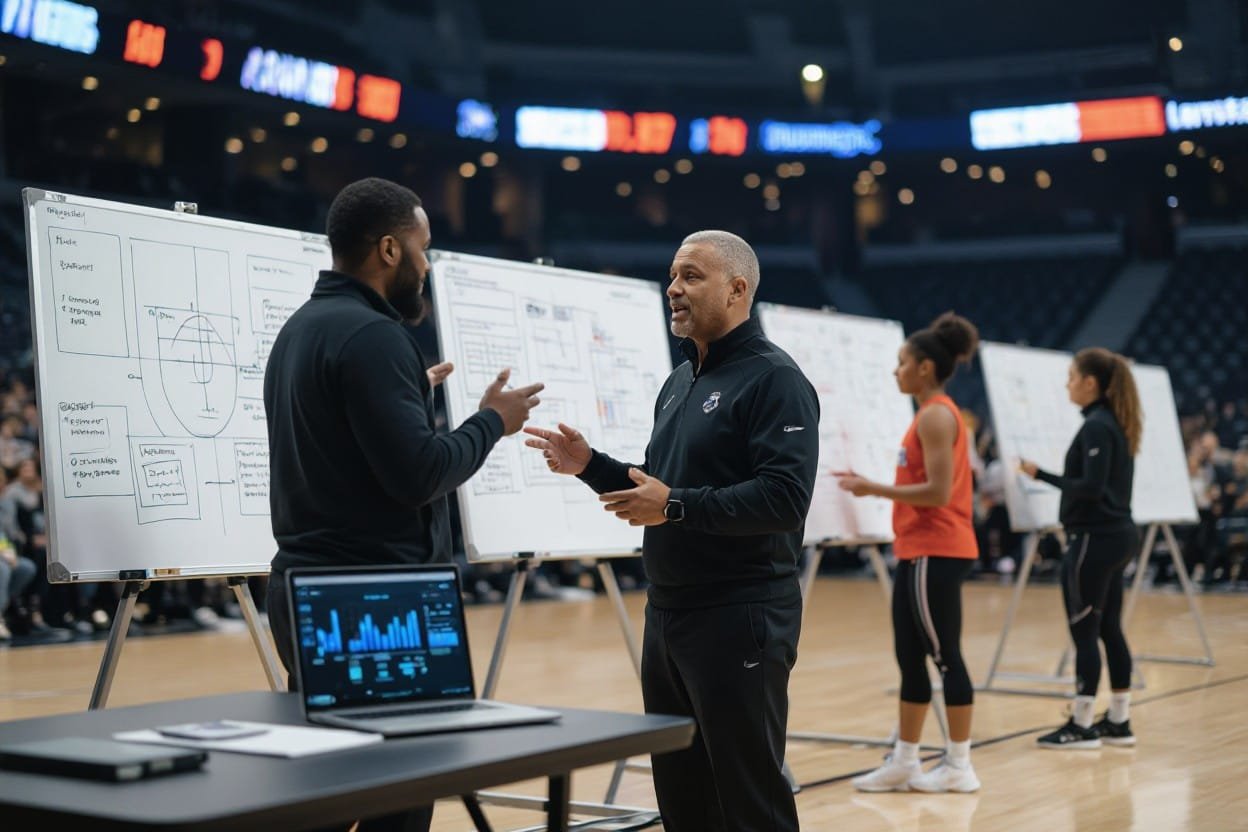Why AI Won’t Replace Human Coaches
The Inimitable Human Touch in Coaching
Presence, not just prompts
Maryam, the CFO at a UAE biopharma, shifted after I mirrored her line—within a minute her shoulders unclenched and a long out-breath opened a conversation about loneliness and guardedness; that real-time attunement is why, at Your Career Place, I prioritise in-person engagement over algorithmic scripts. I know you can get useful frameworks from tools—see AI won’t replace coaches, but it will replace coaching without outcomes—but your readiness and micro-reactions decide what transforms, not just the right answer, and Your Career Place models that in every executive session.

Key Takeaways:
- At Your Career Place, we’ve seen coaching work because of human presence — tone, silence and trust unlock insights (as with Maryam). AI can suggest answers, but it can’t be the companion who creates that shift.
- AI is a powerful support tool for summaries, practice and nudges. We at Your Career Place use AI to amplify coaching, never to replace the emotional and relational work.
- Human coaches judge what insight is timely and bearable, co-create trust and accompany people through emotion and meaning — real-time relational work that can’t be simulated.
Emotional Intelligence: The Ace Up a Coach’s Sleeve
I rely on emotional intelligence to read the tiny shifts that change a session’s trajectory. In the Maryam example, a repeated line and a slight tonal shift unlocked tears and reflection; that kind of movement is what I train coaches to notice at Your Career Place. Those micro-moments—eye focus, breath, posture—tell me whether to hold silence, probe, or offer a frame.
Recognizing and Responding to Non-Verbal Cues
I watch eye direction, micro-expressions, breath patterns and muscle tension to decide my next move. When Maryam’s eyes went to the corner and then narrowed, I matched my tone and echoed her words rather than supplying content; the change in her breathing and softened shoulders signalled readiness to go deeper, and that single calibration opened the work.
Building Trust Through Genuine Interaction
I build trust by being visibly present and willing to be affected, not by fixing. At Your Career Place I model authenticity: concise reflections, calibrated silence, and consistent follow-through on commitments. That steadiness lets clients like Maryam risk vulnerability; she told me later she felt “seen,” which is the operational definition of trust in coaching practice.
I use specific techniques to sustain trust: mirroring posture or tone for attunement, naming observed emotions to validate experience, and offering tiny self-disclosures to signal reciprocity. With Maryam I paused after echoing her line, held my posture steady, and let the silence do the work—she then softened and spoke about loneliness. You can test this: reflect a short phrase, watch for micro-changes, and only then decide whether to challenge or contain.

Contextual Adaptability: More Than Just Data
In Maryam’s session I watched context override a tidy data point: a repeated phrase, delivered in the right tone, unlocked her vulnerability. Algorithms can index sentiment and surface patterns, but they won’t feel the room shift the way I did. At Your Career Place I train coaches to use those shifts as signals, not triggers, and to discern when a model’s insight will help versus when it will harm. For a provocative view, see Why AI Will Replace Most Business Coaches.
Tailoring Strategies to Unique Situations
I adapt interventions to the person in front of me: with Maryam I set aside strategy templates and simply reflected her line back, which softened her defences and opened space for authenticity. At Your Career Place we map interventions to readiness—delaying a leadership framework until trust is rebuilt, or introducing a 360 review only after emotional safety is re-established—so you get a plan that lands and sticks in your context, not one-size-fits-all advice.
The Role of Experience in Decision Making
Experience lets me anticipate consequences of an intervention before I offer it: I can sense whether a data-driven recommendation will motivate action or provoke resistance, and I choose the framing accordingly. That tacit judgment emerges from repeated, varied practice with leaders in different cultures, industries and pressure points.
Across dozens of senior engagements I’ve learned patterns you won’t find in a dataset: micro-timing of a question can convert defensiveness into curiosity; a gentle challenge at minute seven can prevent a shutdown at minute twelve. In Maryam’s case that single reflective repeat—timed after a long silence—shifted her posture and started genuine exploration. Those micro-adjustments—tone, pace, sequencing—are the product of embodied experience that I bring to each Your Career Place coaching session.
Motivation and Inspiration: The Human Advantage
I watched Maryam move from guarded silence to a long outbreath because I chose presence over prescription; that shift is where motivation is born. At Your Career Place I’ve seen how a coach’s calibrated tone, timely silence and genuine curiosity convert fatigue into possibility, often within a single session. You don’t just get ideas from me—you experience being seen, which research and practice show drives sustained behaviour change far more reliably than a neat algorithmic solution.
Understanding Individual Aspirations and Goals
I listen for the story behind your goal—the hopes, the compromises and the hidden costs—because generic frameworks miss the nuance that makes goals motivating. In Maryam’s case, uncovering loneliness behind ambition reframed a performance problem into a leadership identity issue. I map aspirations into concrete 90-day milestones you can tolerate and stretch toward, and I use quick checks—like a 1–10 clarity rating—to track progress so motivation doesn’t evaporate between sessions.
Cultivating a Supportive Atmosphere for Growth
I build psychological safety through simple, repeatable moves: echoing language to show I’m tracking you, softening my tone to invite vulnerability, and holding silence long enough for reflection. In the room with Maryam, that blend—no advice, just attunement—opened honest conversation about disappointment and ambition. At Your Career Place I train coaches to treat the relationship as the intervention, because a supportive container lets challenging work land and stick.
Practically, I start sessions with a two-minute check-in where I ask you to name one feeling and one outcome you want; that small ritual anchors attention. I use calibrated reflections, somatic observation (posture, breath), and a readiness scale to decide whether to probe or to pause. For leaders like Maryam, this approach reduces reactivity: people who feel seen report greater risk-taking in development, and I’ve watched defensiveness soften within a single, well-handled exchange—the exact moment AI cannot manufacture.
The Limitations of AI: Beyond Algorithms
Algorithms excel at pattern detection but not at holding a room the way a human does; I saw that with Maryam when a simple repetition of her sentence shifted the whole session. Models optimize for predictive accuracy, not for bearing a client’s vulnerability, and datasets like Buolamwini & Gebru (2018) show error rates up to 34% on darker-skinned faces versus under 1% on lighter-skinned males, exposing clear limits. At Your Career Place I balance AI utility with human presence because the difference between insight and transformation is relational, not computational.
The Challenge of Empathy in AI Solutions
I watched silence work as an intervention: my tone and willingness to be present moved Maryam more than any answer could have. AI can mimic empathetic language, but cannot actually feel attunement, read micro-expressions across cultures, or sit with your discomfort. You notice subtleties—a held breath, a tightened jaw—that signal readiness for a different kind of question; those signals often fall outside model inputs. At Your Career Place I teach coaches to use those human data points, not to outsource them to a screen.
Overcoming Algorithmic Bias in Coaching
Bias shows up when models are trained on unrepresentative data or proxies that correlate with protected attributes; ProPublica’s 2016 COMPAS analysis and facial-recognition studies illustrate tangible harms. I insist that any tool we use at Your Career Place undergoes bias testing, including subgroup performance checks and error-rate breakdowns, because coaching decisions informed by skewed outputs can misdirect careers and damage trust.
To mitigate bias I recommend concrete steps: (1) audit training data for demographic gaps and remove harmful proxies, (2) run fairness metrics—false positive/negative rates across groups—and publish results, (3) maintain human-in-the-loop review for high-stakes recommendations, and (4) co-design tools with diverse clients so the model reflects lived realities. I also use scenario testing with real coaching transcripts (anonymised) to catch edge cases where a prompt might nudge a client toward stereotyped advice. These practices help AI serve coaching without supplanting the relational judgment you need.
Final Words
On the whole I believe AI won’t replace human coaches because I show up with presence, intuition and a willingness to be moved by your story, which AI cannot replicate. At Your Career Place I draw on the relational craft that helps you discover the answers you’re ready for, not just deliver insights. I use AI as a tool, but Your Career Place is where human connection and skilled accompaniment make transformation possible.
Thank you for visiting Your Career Place. Here are some other articles to review.
https://yourcareerplace.com/make-your-online-presence-better/
https://yourcareerplace.com/courses/the-ultimate-guide-to-leveraging-linkedin-for-career-success/
https://yourcareerplace.com/master-effective-communication-for-professional-development-success/

